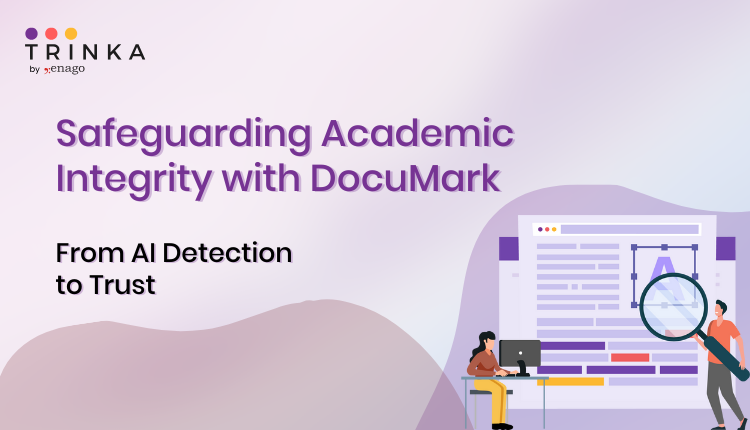In the evolving landscape of education, where AI tools are increasingly available to students, institutions face a challenging question: How can academic integrity be upheld without turning every assignment into a distrust-driven exercise? The recent webinar “Safeguarding Academic Integrity: How DocuMark Relieves Faculty Stress of AI Use” provides a thoughtful framework. Below are the highlights, insights, and a roadmap for educators.
A New Reality in the Classroom
AI tools are accessible to students everywhere. For educators, that raises a pressing question: how do you uphold academic integrity without treating every student as a potential offender?
Radwa pointed out that overreliance on AI detectors is not only technically unreliable leading to false positives and unnecessary disputes but also emotionally exhausting for faculty. Constantly policing assignments drains time and energy that could be spent on mentorship and teaching.
At the same time, the absence of clear policies leaves students in a grey zone. Many may misuse AI unintentionally, simply because they haven’t been guided on where the line between acceptable support and misconduct lies.
Beyond Detection: The Real Challenges
Limits of AI detectors: Tools that simply detect AI usage are often inaccurate or misleading, leading to false positives, student anxiety, or resentment. Relying purely on detection fosters distrust rather than learning.
Faculty stress: Professors, supervisors, and integrity officers are under pressure of having to police work, interpret ambiguous detector results, and deal with academic misconduct. This is taxing and often reactive rather than preventive.
Student ownership and transparency: Without clear policies or understanding, students may misuse AI tools unintentionally or hide usage, diminishing their ability to reflect and learn responsibly.
Reframing the Approach with DocuMark
DocuMark is a research integrity tool, that adds a different prospective on education by changing how AI assisted content is approached and shifting the focus back into learning.
Some of its core features and roles:
Documentation of AI use: Students are encouraged to disclose when and how they used AI. This doesn’t assume wrongdoing; it opens a conversation.
Guidance rather than punishment: Policies paired with DocuMark are designed to support students, helping them understand AI’s role and limitations, rather than just penalizing misuse.
Reducing ambiguity: Clear expectations regarding AI, together with documentation, help reduce misunderstandings between faculty and students about what is acceptable.
Key Takeaways and Best Practices
From the webinar and related discussions, here are strategies educators and institutions can adopt.
| Strategy | What it means in practice |
| Policy clarity | Create institutional policies that define acceptable AI use and require transparent disclosure of AI assistance. |
| Proactive education | Offer workshops or resources for students about how to use AI ethically, distinguishing between assistance and misrepresentation. |
| Shift from policing to trust | Use detection tools selectively, as secondary checks rather than the first line of defense. Prioritize reflective practices, where the dashboard automatically captures and presents the student’s writing process. |
| Faculty support | Provide instructors with clear tools and frameworks (like DocuMark) so that judging AI usage becomes less burdensome and stressful. |
| Cultural change | Move the institutional culture toward honesty, learning from mistakes, and shared responsibility rather than fear of punishment. |
Why This Shift Matters
When universities adopt this approach:
- Faculty experience less burnout by focusing on teaching, not chasing ambiguous cases.
- Students become more thoughtful, knowing they must reflect on their process.
- Institutions build reputation and trust by showing they can embrace innovation responsibly.
Yet, challenges remain to ensure fairness across disciplines, managing implementation overhead, and keeping pace with fast-evolving AI tools. As Radwa noted, “The solution isn’t to ban or fear AI—it’s to integrate it responsibly.”
Closing Thoughts
The webinar highlighted a powerful shift in perspective: safeguarding academic integrity in the AI era is not about suspicion, but about structures of trust.
DocuMark reflects this philosophy, supporting both educators and students in navigating new technologies with clarity and accountability. For universities, the path forward lies in transparency, shared responsibility, and a culture that embraces both innovation and integrity.
View the complete webinar here for practical insights on upholding academic integrity with AI

